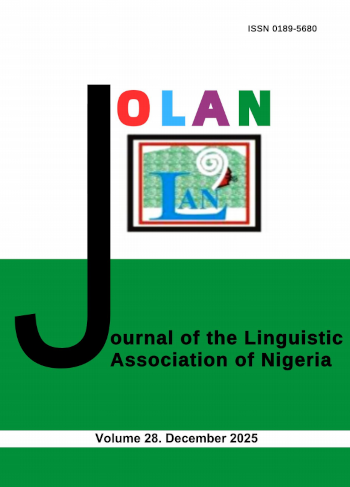The Numerical Systems in Hausa Sign Language
Keywords:
Hausa sign language, Parameters, Numerical systemAbstract
Hausa sign language is human language whose forms consist of sequences of movements and configurations of hands and part of the body which include of arms as well as face and upper torso. The term Hausa sign language is to refer to the language which consist variety of signs such as iconicity, indexical, arbitrary and gesture etc. The paper intends and examines numeration of Hausa sign language (HSL) which processed through the use of hand configuration and perceived in visual/gestural modality. However, the paper describes numeral system of Hausa sign language (HSL) via illustrate of unit, tenth, hundred and thousand categorically. The main objective of the paper is demonstrated the functions of sign parameters (handshape, movement, location and orientation) in the production of sign numeration in Hausa Sign Language.
References
Battison, R. (1974). Phonological Deletion in American Sign Language. Sign Language Studies 5: 5-19.
Kendon, A. (2004). Gesture: Visible Action as Utterance. Cambridge: Cambridge University Press.
Kourbetis, B & Girtis, K. (2004). Numbers and Numeration in Greek Sign Language, 21st Greek Convention on Mathematical Education Proceedings, Hellenic Mathematical Society, Trikala.
Müller, C. and Roland, P. (eds.). (2004).The Semantics and Pragmatics of Everyday Gestures. Berlin: Weidler.
Newport, E. and Supalla T. (2000). “Sign Language Research at the Millennium”. In K. Emmorey and H. Lane (eds.) The Signs of Language Revisited: an Anthology in Honor of Ursula Bellugi and Edward Klima. Mahwah, NJ: Lawrence Erlbaum Associates.
Orie, O. O. (2013). From Conventional Gestutres to Sign Language: The Case of Yoruba Sign Language. In O.O. Orie and K. W. Sanders (eds.) Selected Proceedings of the 43rd Annual Conference on African Linguistics: Linguistic Interfaces in African Languages. Cascadilla Proceeding Project, Somerville, MA.
Papadopetrakis, E. (2002). The Language in Shaping the Concept of Natural Number in Children. Multilingual Environment Problems, ‘Teaching of Language and Mathematics. Linguistic Minorities Education’, Paratiritis.
Papadopetrakis, E. (2003). Natural Language- Mathematical Language. Redefinition Examples, Z' Greek Convention ‘Teaching of the Greek Language in Primary & Secondary Education’ proceedings, Kodikas.
Pfau, R & Steinbach, M (2006). “Pluralization in Sign and Speech: a Cross-Modal Typological Study.” Linguistic Typology 10 (2), 135-182.
Schmaling, C. (2000) Maganar Hannu: The Analysis of Hausa Sign Language. Germany: University of Hamburg.
Senghas, A. (1994). “The Development of Nicaraguan Sign Language via the Language Acquisition Process.” In D. MacLaughlin and S. McEwen (eds.) Proceedings of the Boston University Conference on Language Development 19, pp 543 - 552. Boston: Cascadilla Press.
Senghas, A., Özyürek, A., and Kita, S. (2002). “Encoding Motion Events in an Emerging Sign Language: From Nicaraguan Gestures to Nicaraguan Signs.” In A. Baker, B. van den Bogaerde and O. Crasborn (eds.) CrossLinguistic Perspectives in Sign Language Research. Selected Papers from TISLR 2000, Pp. 119 - 130.Hamburg: Signum Press.
Soyye, F.A. and Lájuyìgbé, A.O. (1993). “Numerals in Yorùbá: An Investigation of Native Speakers’ Knowledge of a Language Sub-system.” Research in Yorùbá Language and Literature 4. 123-125.
Xeroudakis, A (2005). The Numerical System of Greek Sign Language. PhD Dissertation, University of Patras, Greece.














